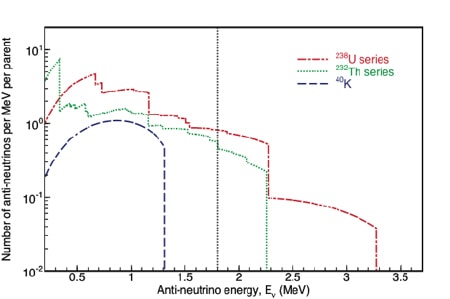The KamLAND experiment in Japan has detected neutrinos produced by radioactive decays deep inside the Earth for the first time. The experiment, which is located in a mine 1000 metres below ground, has detected electron antineutrinos from the beta-decay of uranium-238 and thorium-232, and placed an upper limit on the heat generated by these processes. If the accuracy of the measurements can be improved it may be possible to use "geoneutrinos" to probe the Earth's interior (Nature 436 499).

Neutrinos are very difficult to detect because they are electrically neutral and only interact weakly with matter, which means that they can pass through thousands of kilometres of matter without being absorbed. The Kamioka Liquid scintillator antineutrino detector (KamLAND) comprises a balloon with a diameter of 13 metres contains about 1000 tonnes of liquid scintillator. It identifies antineutrinos by counting the number of telltale flashes of light that are produced when antineutrinos occasionally collide with protons in the liquid to produce a positron and a neutron.
The amount of light produced by the positron allows the energy of the neutrino to be determined, which enables the KamLAND team to distinguish between neutrinos from the decay of uranium and thorium and background neutrinos. Using this method, the experiment detects about one geoneutrino per month. The background sources include neutrinos produced by nuclear reactors, which have been used in other experiments to explore the fundamental properties of neutrinos.
The KamLAND results have already been used to place an upper limit on the heat generated by uranium and thorium inside the Earth. “Unlike previous estimates, which are based on indirect samples from meteorites, this is based on a direct measurement of the neutrinos produced by the decay of these isotopes,” team member Nikolai Tolich told PhysicsWeb. “The heat generated by uranium and thorium decay is the driving force for mantle convection, and hence plate tectonics and earthquakes. This result and future measurements using the same technique will provide useful inputs to Earth convection models.”
“We now have a diagnostic tool for the Earth’s interior in our hands,” added KamLAND spokesman Atsuto Suzuki. “For the first time we can say that neutrinos have a practical interest in other fields of science.”




